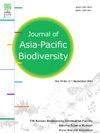蜜蜂会影响西高止山脉特有的一种竹的授粉吗?
IF 0.7
Q4 BIODIVERSITY CONSERVATION
引用次数: 0
摘要
山茱萸(床)Benth。甘布尔是印度西高止山脉的一种重要的地方性芦苇。这种芦苇的大量种群通过在生态系统中固定二氧化碳直接影响全球变暖的减缓。通过对花生物学特征及其对访花者的影响进行分析,了解金盏花雌雄相花的传粉机理。金凤花两性花为雌雄同体。柱头在花药开裂前就开始丧失感受性,外来花粉在芦苇种群中保持遗传变异。花期分离间接导致了自交不亲和,从而保证了种群间的遗传多样性。通过育种试验,得出了冠状花属自交不亲和(自交不坐果)的结论。在开放授粉中,花暴露于风和昆虫的访问中,坐果率最高(70.4%)。花期和访花率指数的统计差异表明,由于开花奖励的有效性,api的雄期访花率较高。方差分析(双向)结果证实了两个花期昆虫访视的差异。这是第一例蜜蜂传粉系统在O. travancorica确认。这一结果为这一假说提供了明确的证据,证明了这一假说是Apis sp.的一种适应性性状。本文章由计算机程序翻译,如有差异,请以英文原文为准。
Do honey bees affect pollination in the flowers of Ochlandra travancorica, an endemic bamboo of the Western Ghats?
Ochlandra travancorica (Bedd.) Benth. ex Gamble is an economically crucial endemic reed of the Western Ghats, India. Mass populations of this reed directly affect global warming reduction through CO2 fixation in the ecosystem. The floral biology and their impact on floral visitors were analyzed to understand the pollination mechanism of male and female phase flowers of O. travancorica. The bisexual flowers of O. travancorica were protogynous. The stigma started to lose its receptivity before the dehiscence of anthers, and the alien pollen was expected to maintain genetic variations in the reed population. The separate flowering phases of O. travancorica indirectly entail self-incompatibility to ensure genetic diversity among the populations. Based on the breeding experiments conducted, it was concluded that O. travancorica was self-incompatible (no fruit set in autogamy). The highest fruit set (70.4%) was recorded in open pollination, where the flowers were exposed to both wind and insect visits. The statistical differences recorded between the flowering phases and the Visitation Rate Index indicated that the male phase has been reported with higher visitation rate by Apis sp. due to the availability of floral rewards. The analysis of variance (two-way) results have confirmed the differences in insect visitation in both flowering phases. It is the first case of a honey bee pollination system identified in O. travancorica. It provides clear evidence for the hypothesis that it is an adaptive trait of the fruit-setting behaviour of O. travancorica by Apis sp.
求助全文
通过发布文献求助,成功后即可免费获取论文全文。
去求助
来源期刊

Journal of Asia-Pacific Biodiversity
Agricultural and Biological Sciences-Insect Science
CiteScore
1.70
自引率
12.50%
发文量
94
审稿时长
27 days
期刊介绍:
The Journal of Asia-Pacific Biodiversity (previous title was Journal of Korean Nature) is an official journal of National Science Museum of Korea (NSMK) and Korea National Arboretum (KNA). The scope of journal is wide and multidisciplinary that publishes original research papers, review articles, as well as conceptual, technical and methodological papers on all aspects of biological diversity-its description, analysis and conservation, and its application by humankind. This wide and multidisciplinary journal aims to provide both scientists and practitioners in conservation theory, policy and management with comprehensive and applicable information. However, papers should not be submitted that deal with microorganisms, except in invited paper. Articles that are focused on the social and economical aspects of biodiversity will be normally not accepted.
 求助内容:
求助内容: 应助结果提醒方式:
应助结果提醒方式:


